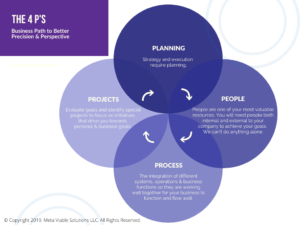Month: December 2021
Jumpstart Your Business Growth With a Fractional COO


“I dream things that never were, and I say ‘Why not?'” — George Bernard Shaw
As an entrepreneur, you leapt headlong into your venture without all the answers, confident you’d figure out what you need to know along the way. Wearing many hats and spinning lots of plates, you inspired others to join you, and, together, you grew. Now your business has hit an impasse or plateau. You know what got you here isn’t going to get you where you want to go. But you’ve maxed out your capacity and don’t have the in-house knowledge, skills, experience, or perspective to do what’s necessary to take things to the next level.
If this sounds like you, congratulations! You’ve already built a viable small business. What’s more, you may be just one key hire away from jumpstarting your next phase of breakthrough growth.
Why a Fractional Leader?
With the fractional model, you gain access to a higher level of executive leadership whose talent and experience would otherwise be unavailable to you. Fractional leaders aren’t cheap, but they can be affordable to a small business or cash-strapped startup because they work only part-time for each client and typically don’t require benefits or equity.
In essence, you’re “renting” a fractional executive for a period of time to help your business grow to the next level. Once your fractional executive has accomplished that goal for you, they’re usually happy to help you find, hire, and groom their full-time replacement, if necessary. Then they move on to their next growth challenge — generally what excites them most.
You may be wondering: With so much to do, how can a fractional executive possibly transform my business if they’re not working full time? The short answer is it depends on how you use them. If you’re looking for someone to take mundane tasks off your plate, you’re unlikely to achieve the level of growth you’re seeking.
But if you let them focus primarily on growing the business, an experienced fractional exec can get the job done much faster, more effectively, and with far less risk than a first-timer. One way to think of it: hiring a fractional executive is like plugging your business into a higher voltage battery. While you may not need to use all the battery’s power to run your company just yet, the engine that will drive your business’s growth won’t even start without it.
Why Start With a Fractional COO?
Today, you can hire all kinds of fractional executives — CMOs, CFOs, CHROs, etc. Many founders/CEOs build whole teams of fractional executives to grow their businesses. However, if you’re considering your first fractional hire, and you need help growing your business more or less across the board, you may be best off starting with a fractional chief operating officer (COO).
Why? While the function of a COO varies from business to business, the scope of a true COO’s responsibility is the entire organization, not just a single business function. They must take a holistic view of the business and understand how it all works together as a dynamic system — made up of interconnected functions, processes, inputs and outputs — itself part of an even larger system, for example, the marketplace.
In addition, a fractional COO often has deep hands-on experience in most, if not all, aspects of a business — sales, marketing, product development, finance, technology, HR, customer service. They not only understand the system as a whole but also have at least working knowledge of the different subsystems and how they all relate to each other and the whole.
To use a medical analogy, one of the functions of a good COO is to serve as a sort of trusted primary care physician who can evaluate the health of your entire business, make accurate diagnoses, prescribe the right treatments or cures, and refer you to specialists as necessary.
To carry the analogy further, they must also have an excellent bedside manner, knowing how to communicate effectively with all different types of employees, across all functions and contexts, 360 degrees, as well as customers, vendors, partners, investors, and so on.
Executing for Business Growth
However, the “doctor” analogy stops there. A fractional COO isn’t a mere consultant who spends the metaphorical equivalent of 15 minutes examining your business, writes you a prescription, and then beats a hasty retreat. No, a fractional COO works in your business as well as on your business, moving fluidly from analysis, strategy, and planning to execution; driving progress each week; holding people accountable for results; testing, measuring, learning, and — if they’re doing their job — continuously improving performance and growing your top and bottom lines.
As Oliver Wendell Holmes said, “Many ideas grow better when transplanted into another mind than the one where they sprang up.”
A great fractional COO will take your vision and run with it, in the process making your long-sought business dream a present-day reality. You can learn more about the benefits of fractional leadership here.
About the Author
Mark Scrimenti is a Fractional COO and Fractional Integrator for businesses running on EOS. He has 15-plus years of leadership experience in e-commerce, digital product development, sales, marketing, and customer experience. Connect with Mark on LinkedIn or visit his website at vividpathconsulting.com if you’re ready to jumpstart your own business’s growth.
5 Steps for Setting Up Your Fractional Services Business


Congratulations! You’re launching a fractional services business. Providing fractional services benefits both you — allowing you to live your ideal life — and those entrepreneurs seeking your knowledge and expertise to take their business to the next level.
Step 1 – Ideate Your Fractional Business Plan
Step one in setting up your fractional practice is defining who you are, what unique services you offer, and whom you will provide services. In addition, deciding how you provide value and for what cost is key. Whether you use an operating system such as Entrepreneurial Operating System (EOS®) where the V/TO is foundational, or you develop a business plan outlining your strategy and goals, the creation of your business plan comes first. Include any personal or professional partners in the discussions for support.
STOP HERE — IMPORTANT!!! As you launch, be certain you have undertaken the necessary steps to understand the financial impact building a new practice can bring. Having stable savings from which to draw the first year is essential. The time and efforts of relying on clients to pay invoices on time and develop, send, and follow up on those invoices should not be underestimated. Ok, now you can keep reading…
Step 2 – Develop Measurable Goals
Layered on the business structure should be specific and measurable goals, both professional and personal. What does the life you want to live look like? How will you make that ideal life a reality? Where do you bring value to your clients? What are your passions, and how do you translate those passions to make a difference? With what types of people do you work best? Who then is your ideal client? These are all questions to consider — among others.
Step 3 – Setup Your Business Name
Once your fractional services business is defined, select a name. Carefully choose a unique moniker that allows others to identify the nature of your business easily. Then register the name and chosen structure (LLC, S-Corp, etc.) in your local jurisdiction, partnering with appropriate legal and financial entities to ensure proper adherence to rules and regulations.
Step 4 – Determine Your Fractional Services
Identify your service offerings based on your ideal client needs, layered with the value you can provide. When it comes to pricing, remember that we always tend to under-value our worth. It is always a good idea to run your pricing structure by a mentor or valued partner (preferably someone in a similar type of business).
Step 5 – Get Out There and Network
You’ve likely been networking throughout creating and building the business. Perhaps you even have your first client — or three — set to sign with you as soon as you’re ready! Open, honest, and authentic conversations with your network and potential clients will return to you in spades. Be clear about who you are, what you offer, and the value you provide. At the same time, know when to say “no.” By staying true to your personal and professional core values, the benefit you bring is that much stronger.
With a good business plan in place, your ideal personal life outlined, your value proposition, pricing, and business name defined, you’re ready to work with clients. Be realistic about the time required both ON the business and IN the business.
Your calendar is your best friend. Schedule days/time for business development, work with clients, and administrative duties. Then seek out organizations where your ideal clients are tuned in. Participate, give back, and use those resources to stay in front of those perfect clients. You can also join the Fractional Leadership Network.
Peer groups and valued partners can be important referral sources for the delegation of business areas that do not play to your strengths or when additional help is needed. Delegation in your personal and professional life is the key to getting the things you should not be doing off your plate and giving you the time to focus on your Unique Abilities. One example: I have not cleaned my house in seven-plus years. I hate cleaning; it’s a distraction for me. Seeing dog hair in the corner doesn’t bother me, knowing Cindy will be here in a few days to clean. I am also supporting Cindy and her small business — a total win/win!! Remember: just because you CAN, doesn’t mean you SHOULD.
Now, Reap the Rewards
Fractional work is a balancing act. The rewards can be huge! Patience, persistence and understanding you are running a marathon — not a sprint — are all necessary. Congratulations on building your fractional practice! Now get out there and offer your expertise to the world with confidence!
About the Author
Jamie Munoz is the founder and visionary of a team of Fractional Integrators at Catalyst Integrators, helping busy visionaries and entrepreneurs maximize their potential by running companies on EOS. Jamie is also a certified John Maxwell Team coach, speaker and trainer. Contact Jamie here.
Mergers and Acquisitions — Selling Your Small Business


Your fiercest competitor has just submitted a letter of intent to acquire your business. How do you respond? Is the offer a good one? Is it the right time to sell? What are customary terms and deal processes? If you’re like approximately 90 percent of business owners out there, you’ve never been involved with the sale of a business (particularly your own). You would likely have a host of questions similar to these.
Business sale or sell-side mergers and acquisitions (M&A) transactions are “unique beasts,” and the stakes are too high to go it alone or enter the fray without the proper advisors.
If you’re prudent and well prepared for a sale, you can avoid the mistakes that befall many an unsuspecting seller. These can include an outsized strain on your day-to-day operations, suboptimal deal terms and value (i.e., lower sales price and unattractive terms), and an inefficient deal process. Remember that it is critical to communicate — whether orally, in writing, or through the sharing of company information — with intention and that “time kills deals.”
Hiring a Fractional Leader Can Optimize Your Business for Sale
Working with experienced fractional leadership (CMO, CSO, COO, etc.) months or years ahead of a prospective transaction — whether vaguely conceptual or immediately actionable — can supplement your core team. Domain experts can supercharge your operations and optimize the value and attractiveness of your business.
Additionally, a Fractional CFO experienced in M&A can provide transaction-related guidance alongside ongoing strategic financial oversight. When the time comes to “go to market” (proactively pursue a sales process) or respond to the unsolicited acquisition offer, you’ll have experienced advisors on hand. And you will be prepared with financial results and operating data tailored to your audience of third-party investors and acquirers.
Regardless of whether a transaction is ultimately pursued or consummated, by going through the process, you’ll likely have received outsized value in the form of a more sustainably profitable and well-run business.
About the Author
Landon Mizuguchi has over 15 years of experience encompassing M&A, general management, corporate finance, and valuation, with preeminent professional services firms such as Goldman, Sachs & Co. and EY (formerly Ernst & Young). As principal of Malama Capital Advisory, he provides Fractional CFO and M&A advisory services to West Coast-based SMBs and hyper-growth startups. Contact Landon here.
Your Business and the Power of Process


As founder and fractional chief operations officer (COO) of Meta Viable Solutions, I have realized the Power of Process and how it can benefit businesses regardless of size. Process is integral in building a strong business from the ground up. It allows you to provide efficient business models that will help your business produce, grow, scale and profit.
Process also allows you to pivot and tweak your business, when necessary, as all systems don’t work all the time. As a leader and visionary in your company, process allows you to execute your great ideas into tactical, approachable steps to reach high-level goals.
A Business Path to Better Precision and Perspective
The 4P Model for a Business Path to better Precision and Perspective allows business objectives to be realistic and manageable. This model helps with effectiveness and efficiency when managing your team and avoiding employee burnout. It infuses your company with productivity, motivation, ingenuity and progress.

The 4P Model consists of Planning, People, Process and Projects. These four elements are all interrelated and must work together for you to be successful. You can’t have new systems and technologies without people.
There needs to be planning, process integration, training and special initiatives or projects to get ideas and plans off the ground. One can’t exist without the other.
- Planning is key before embarking on a new initiative. We often refer to this stage as strategic planning. It allows you to put the required people, budgeted finances, and time in place
- People are one of your most valuable resources. You will need people both internal and external to your company to achieve your goals. What roles and expertise do you need to accomplish your business goal or project?
- Process is needed to integrate different business functions, experts, systems and operations in your company, so they are working well together. How will you get to where you are going? You will need to ensure everyone is working together and the right communication processes and workflows are implemented.
- Projects are a means to the end goal if they are planned, managed and executed well. Your company may have several business initiatives occurring simultaneously. How do you prioritize, track and manage them? Projects allow a way to assign responsibility to team members, evaluate goals and identify special projects to focus on initiatives that drive you toward professional growth and business goals.
Delegating people internally or hiring a team, consultant or Project Management Professional (PMP) can help create manageable and practical projects to reach your business goals.
Successful Businesses Realize What Process Can Do for Them
Let’s take a minute to focus on number three, PROCESS.
The EOS Traction method recommends that all you need is 80 percent of your six core processes documented at 20 percent. It suggests that every company has at least six core processes: Human Resources, Marketing, Sales, Operations, Accounting and Customer Retention.
Well-documented and communicated processes are invaluable and beneficial to your company. Whether you are a one-person business or a 250-employee company, you have processes within your company. You have a method and technique you have developed to work internally and externally with others. These “processes” may be documented, or they may be in your head.
The question is, are they effective, and is everyone working off your built-in processes?
Effective processes save you time, money, and resources in the short and long term.
Four Benefits of Establishing Processes
- Clear processes create a clear direction for your employees, customers and strategic partners. It develops transparency and sets expectations of how policies, procedures and tasks are to be performed. Everyone involved understands how matters will be handled before proceeding with a task. Process mapping, documentation and training are best practice tools to communicate your processes to all those involved internally and externally.
- Process ensures better quality assurance. Having clear processes allows for more consistency and less variance in errors. It allows for productivity and efficiency. Process helps your employees understand their role in the larger context of the company and better meet company standards. Additionally, customers can expect a certain positive level of customer experience when it comes to customer care. Process allows similar quality standards, so your team is accountable, responsive, and meeting a certain standard with your product, service and professionalism.
- Process allows you to build systems and capacity. It is a foundational element (a part of the 4 P model) to integrate different functions and people within the company. It allows for consistency across multi-sites and helps you expand your business once you develop a successful, efficient process model (one that works for you and your customers).
- Process saves you time and money. Everyone is on the same page and understands how things are done, avoiding the loss in time and “figuring things out.” You will experience higher employee and customer satisfaction and better external strategic partnerships with established processes. Process allows you to be resourceful and less prone to liabilities.
Oftentimes, business owners and leadership feel lost and overwhelmed when starting or pivoting a business. Consider Fractional Leadership. Hiring a Fractional Leader can help bring your team and business forward.
If you found these concepts helpful and would like a deeper dive into strategic, practical tips and an easy-to-follow guide on building a stronger foundation for your business, pick up a copy of my book, Striking Business Gold: Build, Scale, Profit for Success.
About the Author
Sasha Lalite, MPA, PMP, is the owner and Fractional Chief Operations Officer of Meta Viable Solutions LLC. As a Fractional COO & Strategic Operations Advisor, Sasha provides expertise to businesses on an outsourced, part-time, or project basis. Connect with Sasha here. She can also be reached at sasha@metaviablesolutions.com or 347-470-7901.
